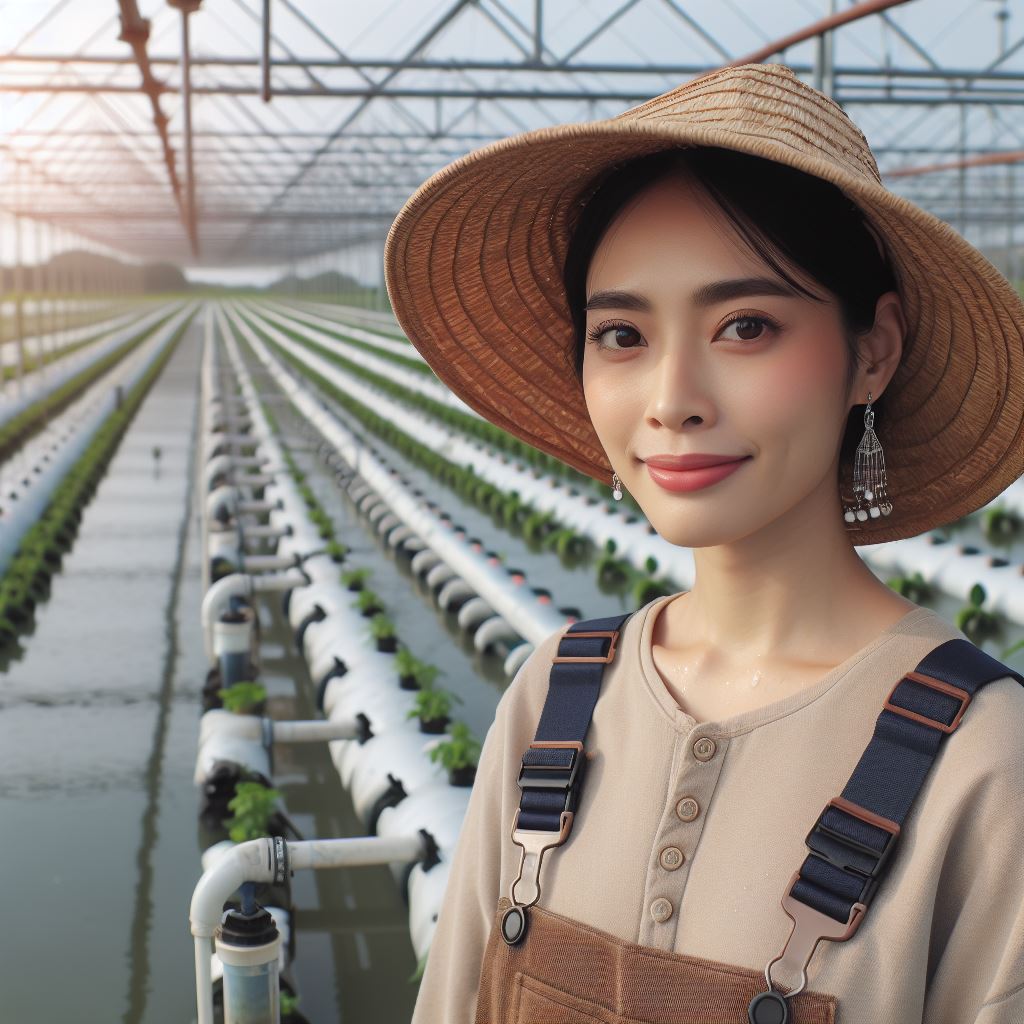Introduction
Drought-Resilient Crops, also known as drought-tolerant crops, are plants that can withstand prolonged periods of water scarcity.
Definition of drought-resilient crops
Drought-resilient crops are genetically modified or naturally adapted plants that exhibit enhanced tolerance to drought conditions.
Importance of drought-resilient crops in agriculture
- Ensuring food security: Drought-resilient crops offer the potential to mitigate the impact of droughts on crop yield, thus ensuring food security.
- Enhancing farmer livelihoods: With drought-resistant crops, farmers can sustain their income even during droughts, safeguarding their livelihoods.
- Water conservation: Drought-tolerant crops require less water for growth, allowing farmers to conserve water resources and reduce irrigation needs.
- Climate adaptation: As droughts become more frequent and intense due to climate change, drought-resilient crops play a vital role in adapting to these conditions.
- Environmental sustainability: By reducing the need for excessive irrigation, drought-tolerant crops contribute to conserving water and preserving ecosystems.
- Economic stability: Drought-resistant crops can stabilize agricultural economies by minimizing crop losses caused by water scarcity-induced droughts.
- Global food production: With a growing population and limited water resources, drought-resilient crops hold promise in sustaining global food production.
Basically, the cultivation and promotion of drought-resilient crops have immense significance in agriculture.
These crops offer solutions to tackle water scarcity-related challenges, ensure food security, and foster sustainable farming practices.
Embracing drought-resilient crops is crucial for the future of agriculture in a changing climate.
Overview of the current situation
Droughts are becoming more frequent and intense globally, posing significant challenges to agriculture and food security.
Drought, a prolonged period of abnormally low rainfall, is a natural disaster that has detrimental effects on crops, livestock, and ecosystems.
In recent years, the world has witnessed an alarming increase in the frequency and intensity of droughts due to climate change.
As temperatures rise and weather patterns become more erratic, regions that were once relatively safe from drought are now experiencing water scarcity.
This trend has raised concerns about the future of agriculture and the ability to sustainably produce enough food to feed the growing global population.
Increase in global drought frequency and intensity
The frequency and intensity of droughts have been steadily increasing worldwide.
According to the United Nations, drought-affected areas have doubled since the 1970s, and more than 1.5 billion people now live in regions with drought-related water scarcity.
Scientists predict that climate change will further exacerbate this situation, with regions already prone to drought facing even drier conditions.
This includes areas such as Southern Europe, Central Asia, the Mediterranean, and the American Southwest.
The primary cause of these more frequent and intense droughts is climate change, primarily driven by human activities.
The burning of fossil fuels releases greenhouse gases, such as carbon dioxide, into the atmosphere, trapping heat and leading to global warming.
This warming alters weather patterns and disrupts the natural water cycle, increasing the likelihood of droughts.
Impact of droughts on agriculture and food security
Droughts present formidable obstacles to agriculture and food security due to their profound impact on water availability.
Crops, vital for sustaining populations, require ample water for growth and development.
However, during droughts, water becomes scarce, severely impeding crop yields and quality.
Farmers confront challenges in adequately irrigating their fields, resulting in stunted growth, diminished harvests, and potential crop failures.
Moreover, water scarcity during droughts adversely affects livestock, which also rely on water for drinking and overall health.
Reduced water availability can leave animals dehydrated, malnourished, and vulnerable to diseases, further exacerbating agricultural challenges.
The ramifications of these drought-induced agricultural hurdles extend beyond individual farmers.
Decreased crop yields and livestock populations lead to limited food supplies, subsequently driving up food prices.
This scarcity disproportionately impacts vulnerable populations, making it increasingly challenging for them to access sufficient and affordable food.
Globally, food security is a pressing concern, with over 800 million people currently undernourished.
Droughts exacerbate this issue by hampering food production and distribution efforts.
To address the mounting challenges posed by escalating drought frequency and intensity, there is an urgent need for drought-resilient crops.
These crops, capable of enduring extended periods of water scarcity without significant yield losses, hold immense promise for safeguarding agricultural productivity.
Plant scientists and breeders are diligently working to develop and enhance these drought-resistant varieties.
By leveraging advancements in genetics and agronomy, they aim to bolster the drought resilience of conventional crop species, ensuring their viability in water-stressed environments.
Drought-resistant crops have the potential to revolutionize agriculture by mitigating the adverse impacts of droughts, bolstering food supplies, and enhancing global food security.
Through concerted efforts to develop and implement resilient agricultural practices, we can navigate the challenges posed by droughts and pave the way for a more sustainable future in food production and distribution.
Transform Your Agribusiness
Unlock your farm's potential with expert advice tailored to your needs. Get actionable steps that drive real results.
Get StartedRead: Climate Change: Its Impact on Corn Yields in the US
Advantages of using drought-resilient crops
Ability to withstand prolonged periods of drought
Drought-resilient crops have evolved mechanisms to survive and thrive during drought conditions, allowing farmers to maintain productivity even in water-stressed environments.
Reduced water requirements
These crops have high water-use efficiency, meaning they can produce more yield using less water.
This not only conserves water but also reduces the burden on irrigation systems.
Enhanced yield stability
By growing drought-resilient crops, farmers can minimize yield losses during droughts.
These crops possess genetic traits that enable them to cope with limited water availability and continue producing good harvests.
Improved soil health and fertility
Drought-resilient crops often possess deep and extensive root systems, which contribute to improved soil structure and moisture retention.
This enhances overall soil health and fertility, making it more suitable for sustainable agriculture.
Furthermore, these crops enrich the soil with organic matter through their roots and above-ground biomass, enhancing soil nutrient content and promoting beneficial microbial activity.
Increased agricultural productivity
Drought-resilient crops offer a viable solution to mitigate the adverse effects of drought on crop yield.
By adopting these crops, farmers can maintain agricultural productivity even in regions prone to regular dry spells.
Reduction in economic losses
Droughts can cause significant economic losses for farmers, leading to food insecurity and financial instability.
Using drought-resilient crops reduces the risk of crop failure, safeguarding farmers’ livelihoods and increasing economic sustainability.
Climate change adaptation
As climate change alters precipitation patterns and increases the frequency of droughts, embracing drought-resilient crops becomes crucial for adapting to these changing conditions.
These crops provide a means to mitigate the impacts of climate change on agriculture.
Conservation of natural resources
By using drought-resilient crops, farmers can conserve water resources, reduce the need for synthetic fertilizers, and minimize the risk of soil erosion.
This promotes sustainable farming practices and helps preserve natural resources for future generations.
Improved food security
Drought-resilient crops ensure a more stable food supply by reducing the dependency on weather conditions.
They aid in meeting future food demands, particularly in regions prone to water scarcity and drought, thereby enhancing food security globally.
Enhanced resilience in vulnerable regions
Drought-resilient crops play a significant role in enhancing the resilience of agriculture in vulnerable regions, such as arid and semi-arid areas.
They provide a sustainable farming option, allowing farmers to adapt and overcome the challenges posed by water scarcity.
Essentially, the utilization of drought-resilient crops offers numerous advantages, such as the ability to withstand drought, reduced water requirements, enhanced yield stability, improved soil health and fertility, increased agricultural productivity, and climate change adaptation.
These crops contribute to sustainable agriculture, economic stability, and food security, while conserving natural resources and building resilience in vulnerable regions.
Embracing drought-resilient crops is essential for the future of agriculture, ensuring its sustenance in the face of changing climate conditions.
Read: Soil Health: Key to Climate Fight
Types of drought-resilient crops
With the increasing threat of climate change and the unpredictability of weather patterns, finding ways to develop drought-resilient crops has become a pressing issue in the field of agriculture.
These crops have the ability to withstand and adapt to prolonged periods of limited water availability, ensuring both food security and sustainable farming practices.
In this blog section, we will explore the different types of drought-resilient crops and their characteristics.
Crops with deep root systems
- Deep-rooted plants like maize, sorghum, and legumes are able to access moisture stored deep in the soil.
- These crops can tap into water sources that are inaccessible to other plants, making them more drought-tolerant.
- The deep roots also improve soil structure and prevent erosion, further enhancing their resilience to drought conditions.
Improved water-use efficiency crops
- Some crops, such as millets and certain varieties of wheat and rice, possess traits that allow them to use water more efficiently.
- These crops have mechanisms to reduce water loss through evaporation, transpiration, and improved stomatal control.
- By optimizing water use, these crops can produce satisfactory yields even in water-limited environments.
Crops with natural defenses against drought stress
- Certain plants have evolved unique mechanisms to combat drought stress, making them inherently more resilient.
- Examples include succulent plants like cacti, which store water in their tissues for prolonged periods of drought.
- Other crops, such as quinoa and amaranth, have developed natural compounds that protect against water loss and maintain cellular integrity during drought.
Developing and promoting these types of drought-resilient crops is crucial for ensuring food security and minimizing the impact of droughts on agricultural productivity.
Farmers and researchers are continuously working together to identify and breed varieties that possess these resilient traits.
Additionally, advancements in genetic engineering and biotechnology are further accelerating the development of drought-tolerant crops.
Besides the categorization based on their traits, various breeding techniques are used to enhance the resilience of crops to drought stress.
These methods include traditional breeding, marker-assisted selection, and genetic modification.
Each approach aims to improve the crop’s ability to tolerate water scarcity by introducing or enhancing specific genes responsible for drought tolerance.
While the development of drought-resilient crops is crucial, it is equally important to implement sustainable agricultural practices.
Conservation tillage, water management, and crop rotation are among the strategies that can complement the use of drought-tolerant crops.
These practices help maintain soil health, minimize water wastage, and maximize the efficiency of available water resources.
Generally, the future of agriculture relies heavily on the development and cultivation of drought-resilient crops.
Crops with deep root systems, improved water-use efficiency, and natural defenses against drought stress are essential for ensuring food security in the face of increasingly unpredictable weather patterns.
By combining these resilient traits with sustainable farming practices, we can build a more resilient and sustainable agricultural system capable of withstanding the challenges of a changing climate.
Read: Managing Farms in Extreme Weather

Case studies of successful drought-resilient crops
Drought-tolerant maize varieties in sub-Saharan Africa have revolutionized agriculture in the region.
- Farmers now have access to maize varieties that can withstand prolonged dry spells and still yield good harvests.
- These drought-tolerant maize varieties have been developed through extensive research and breeding programs.
- They have been specifically designed to withstand water stress and have higher water-use efficiency.
- Farmers who have adopted these varieties have reported significant increases in their crop yields.
- Drought-tolerant maize has not only improved food security but also enhanced livelihoods.
- In drought-prone regions, sorghum and millet varieties have proven to be resilient and reliable crops.
Sorghum and millet are naturally adapted to arid and semi-arid environments, making them ideal for areas with water scarcity.
- These crops have shown remarkable resilience in the face of unpredictable rainfall patterns and prolonged periods of drought.
- Farmers cultivating drought-tolerant sorghum and millet have reported better harvests and reduced economic losses.
- In Asia, drought-resistant rice varieties have played a crucial role in ensuring food security.
- These rice varieties possess traits that enable them to survive and yield under water-limited conditions.
- They exhibit enhanced water-use efficiency, deeper root systems, and improved tolerance to water stress.
Drought-resistant rice varieties in Asia
- Drought-resistant rice varieties have been widely adopted by farmers across Asia, particularly in countries vulnerable to water scarcity.
- These varieties have shown excellent performance even during prolonged dry spells, leading to improved rice production.
- The introduction of drought-resilient crops has not only benefited farmers but also aided in mitigating the effects of climate change.
- By reducing the risks associated with drought, these crops contribute to more sustainable agricultural practices.
- Drought-resistant crops also minimize the need for irrigation, thus conserving water resources in water-stressed regions.
- The success of these crops can be attributed to scientific advancements in crop breeding and biotechnology.
- Ongoing research and development efforts continue to enhance the resilience and productivity of drought-tolerant crops.
- However, challenges remain in terms of ensuring widespread adoption of these crops and addressing socioeconomic barriers.
- Governments, non-governmental organizations, and agricultural institutions need to provide support for the dissemination of drought-resilient varieties.
- Farmer education and training programs are crucial to promote the adoption of these crops and build resilience in agricultural systems.
- In fact, the case studies of successful drought-resilient crops highlight their potential to transform agriculture in drought-prone regions.
- Drought-tolerant maize, sorghum, millet, and rice varieties enable farmers to cope with water scarcity and achieve higher productivity.
- These crops not only contribute to food security but also foster sustainable farming practices and climate change adaptation.
- Continued investments in research, development, and agricultural policies are vital to realize the full potential of drought-resilient crops.
Read: Climate Impact on Crop Yields
Challenges and limitations
As the world grapples with the increasing impacts of climate change, one of the critical issues that need to be addressed is the food security of the growing population.
Drought, one of the major consequences of global warming, poses a significant threat to agricultural productivity, making it essential to develop drought-resilient crops.
While the concept of drought-resistant crop breeding holds immense potential, it also comes with its fair share of challenges and limitations.
Lack of research and development in drought-resistant crop breeding
One of the primary challenges in developing drought-resistant crops is the lack of adequate research and development in this field.
Due to limited resources and funding, researchers face various obstacles in their quest to breed crops that can withstand prolonged dry spells.
Extensive investigations and trials are crucial in identifying the genetic traits that contribute to drought tolerance.
However, the lack of investment in research and development hampers the progress in this area.
High costs of adopting new crop varieties
Another significant limitation is the high costs associated with adopting new crop varieties.
Farmers, especially those in developing countries, often struggle to afford expensive seeds, particularly if they have limited access to credit or financial resources.
The initial investment required to switch to drought-resistant crops can be daunting, making it discouraging for farmers to embrace this transformative change.
Thus, it is essential to find innovative solutions to reduce the costs associated with accessing and implementing drought-resistant crop varieties.
Showcase Your Farming Business
Publish your professional farming services profile on our blog for a one-time fee of $200 and reach a dedicated audience of farmers and agribusiness owners.
Publish Your ProfileSocio-economic impacts on farmers and communities
Moreover, the adoption of drought-resistant crops can have socio-economic impacts on farmers and communities.
In some cases, farmers may face resistance from traditional farming communities who may be hesitant to adopt unfamiliar crop varieties.
Additionally, the transition period from conventional crops to new drought-resistant ones may lead to a temporary reduction in yields, affecting the income and livelihoods of farmers.
As a result, it becomes crucial to provide adequate support and guidance during this transitional phase to ensure a smooth and successful transition.
Despite these challenges and limitations, the potential benefits of drought-resistant crops cannot be overlooked.
They have the ability to provide higher yields, even in the face of limited water availability, thereby safeguarding food security in drought-prone regions.
Furthermore, these crops can reduce the need for excessive irrigation and minimize water waste, making them environmentally sustainable as well.
The development and widespread adoption of drought-resistant crop varieties are, therefore, crucial for the future of agriculture.
Strategies to address the challenges
To address the challenges mentioned earlier, several strategies should be employed.
Firstly, governments and international organizations must invest in enhancing research and development capacities dedicated to drought-resistant crop breeding.
Increased funding will help scientists accelerate their efforts and develop improved crop varieties in a shorter timeframe.
Secondly, governments can provide subsidies and financial assistance to farmers, making the adoption of drought-resistant crops more financially viable for them.
These investments can act as a catalyst for change and encourage farmers to transition towards more resilient crop varieties.
In addition to financial support, farmers should also receive adequate training and education on the cultivation requirements of drought-resistant crops.
Knowledge sharing initiatives and farmer training programs can ensure that farmers are equipped with the necessary skills to successfully grow and manage these new varieties.
Furthermore, raising awareness among farming communities about the benefits and long-term advantages of drought-resistant crops is crucial in overcoming resistance to change.
In short, developing drought-resistant crops is a critical step towards achieving sustainable agriculture in the face of intensifying droughts.
Despite the challenges and limitations, investing in research and development, reducing the costs associated with adopting new crop varieties, and providing support to farmers are key strategies to overcome these hurdles.
By embracing drought-resistant crops, we can secure our food supply, protect the livelihoods of farmers, and build a more resilient agricultural future.
Innovations and Initiatives for Future Development
As the world grapples with the increasing threat of drought, the development of drought-resilient crops has become crucial for the future of agriculture.
Scientists, farmers, and policymakers are working together to explore innovative solutions and promote sustainable farming practices to mitigate the impact of water scarcity.
Here are some key initiatives and technologies that offer hope for a more resilient agricultural future:
Biotechnology and Genetic Engineering for Drought Tolerance
Biotechnology and genetic engineering have opened up new possibilities for developing crops with enhanced drought tolerance.
Scientists are identifying genes responsible for stress response and water conservation in plants, allowing them to modify crops and make them more resistant to drought conditions.
This approach involves introducing specific genes into plants, resulting in improved water-use efficiency and reduced yield losses during water scarcity.
Through genetic engineering, crops can also be engineered to have deeper and more extensive root systems, enabling them to access water from deeper soil layers.
Additionally, scientists are exploring the potential of genetic modification to optimize crop traits such as stomatal regulation and photosynthesis, further enhancing their ability to withstand water stress.
Sustainable Farming Practices to Conserve Water
While developing drought-resistant crops is essential, promoting sustainable farming practices is equally important in managing water resources effectively.
Farmers are adopting various techniques to conserve water and reduce water wastage during cultivation.
One approach is precision agriculture, which involves using advanced technologies such as satellite imagery and sensor-based systems to precisely monitor crop water requirements.
This allows for optimized irrigation, ensuring that crops receive the right amount of water at the right time, minimizing water loss due to overwatering.
Conservation tillage practices, such as no-till farming, aim to minimize soil disturbance and improve water infiltration capacity, reducing evaporation and runoff.
Cover cropping, another sustainable practice, involves planting additional crops to cover the soil surface during fallow periods, reducing soil erosion and water evaporation.
Collaboration between Scientists, Farmers, and Policymakers
The development and implementation of drought-resilient crops require close collaboration among scientists, farmers, and policymakers.
Scientists play a crucial role in developing new varieties and technologies, while farmers provide valuable on-ground insights and feedback.
Policymakers, on the other hand, can facilitate the adoption of innovative agricultural practices and ensure the integration of drought-resilient crops into national agricultural policies.
Collaboration initiatives such as public-private partnerships and knowledge-sharing platforms are bringing together diverse stakeholders to drive innovation in drought-resilient agriculture.
These collaborations enable the exchange of expertise, resources, and best practices, accelerating the development and deployment of drought-tolerant crop varieties.
In review, the future of agriculture lies in the development of drought-resilient crops.
By harnessing the power of biotechnology and genetic engineering, promoting sustainable farming practices, and fostering collaboration between scientists, farmers, and policymakers, we can pave the way for a more sustainable and productive agricultural sector.
Together, we can build a resilient food system capable of withstanding the challenges posed by water scarcity and ensuring food security for generations to come.
Learn More: AI in Agriculture: Facing Climate Change
Conclusion
Investing in research for drought-resilient crops is of utmost importance to ensure a sustainable future of agriculture.
These crops have the potential to mitigate the impact of climate change on agriculture, offering hope for a resilient and secure food production system.
By developing and implementing drought-resistant varieties, farmers can adapt to changing weather conditions and reduce the risk of crop failure.
Additionally, these crops can help conserve water resources, maintain soil health, and reduce the reliance on chemical inputs.
Governments, researchers, and policymakers should prioritize funding and support for research and development in this field.
By supporting scientific advancements, we can accelerate the breeding and deployment of drought-tolerant crops worldwide.
This investment is crucial to ensure food security and livelihoods in regions affected by water scarcity and climate variability.
Drought-resilient crops also present an opportunity to address the socio-economic challenges associated with climate change.
By improving agricultural productivity and farmer resilience, these crops can contribute to poverty alleviation, rural development, and food system transformation.
Moreover, they can enhance ecosystem services, promote biodiversity, and foster sustainable farming practices.
In a nutshell, the development and utilization of drought-resilient crops offer a promising pathway towards a more sustainable and resilient future for agriculture.
By embracing these advancements, we can safeguard global food production, protect vulnerable communities, and mitigate the adverse effects of climate change.
It is imperative that we continue to invest in research and innovation to unlock the full potential of these crops and secure a prosperous future for agriculture.




